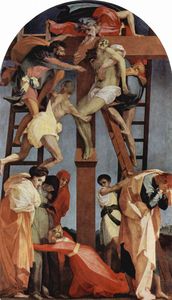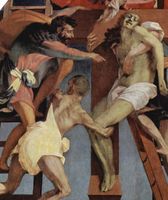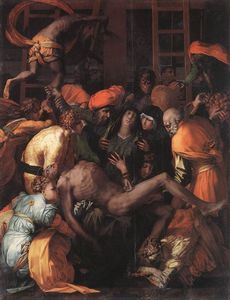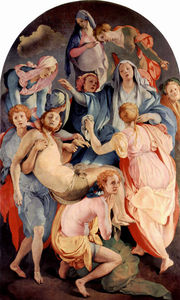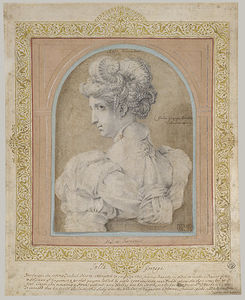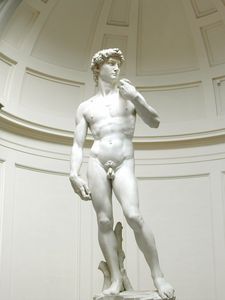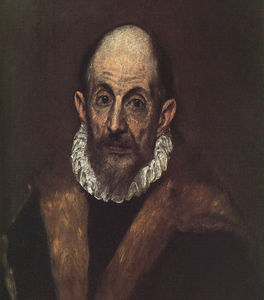Deposition from the Cross
- Date of Creation:
- 1521
- Alternative Names:
- Deposition
- Height (cm):
- 375.00
- Length (cm):
- 196.00
- Medium:
- Oil
- Support:
- Wood
- Subject:
- Scenery
- Art Movement:
- Mannerism
- Created by:
- Current Location:
- Volterra, Italy
- Displayed at:
- Pinacoteca Comunale di Volterra
- Owner:
- Pinacoteca Comunale di Volterra
- Deposition from the Cross Page's Content
- Story / Theme
- Analysis
- Related Paintings
- Artist
- Art Period
- Bibliography
Deposition from the Cross Story / Theme
Considered by many scholars to be Rosso Fiorentino's greatest work this altarpiece is an intense study in color, composition and raw emotion that marked a new era in Mannerism. It is located to this day in the Pinacoteca Comunale di Volterra.
Although Rosso painted another version six years later, the Volterra work holds the attention of scholars and art lovers with its unique ability to capture the anguish of a historical moment.
Deposition from the Cross depicts the moment, recounted in the gospel, when the followers of Christ remove His body from the crucifix. The cast of characters involved generally includes Joseph of Arimathea, (the man with the grey beard) Nicodemus, (reaching out to support the body) St. John the Evangelist, (the red-headed man stooped in grief) the Virgin Mary, and Mary Magdalene (at the bottom throwing herself at Mary's feet).
This theme first became popular in Byzantine art in the 9th century, and was seen in Western art in the following century.
Deposition from the Cross Analysis
Composition:
The upper figures are frozen in a moment of frenzied, grief-laden activity, carrying the body precariously down from the cross. The lower figures seem to exist almost in another reality, serving as symbols of anguish, devoid of the activity suggested by the upper half of the tableau.
The tall figure with red hair, traditionally St. John, is widely considered to be a self-portrait of Fiorentino. By including himself in the composition he becomes part of the emotional intensity of his own work. The position he is in, stooped over in anguish with his head buried in his hands, accentuates this.
Color palette:
The colors in Deposition from the Cross are bold, dramatic and dissonant, inspiring feelings of horror and grief. The body of Christ is a sickly green hue, his reddish hair clashing with the cadaverous tones of his skin.
Mood elicited:
Where previous depictions of the Deposition tended to focus more on the scene itself - the action, the background, and often idealized figures - Fiorentino's work focuses solely on emotion.
The background is practically nonexistent, channeling all of the viewer's energy on the figures stopped in their tracks.
Use of lighting:
The harsh and unnatural lighting seems to come from a flash from above, freezing the participants in a snapshot moment in time.
Brushstroke:
By this point in his career Fiorentino had mastered the art of detail, which is apparent in the figures' expressions. The oil paint is applied in light strokes, creating a smoothness of texture and subtle layered effect.
This technique was seen frequently with Florentine painters, in contrast to the thicker paint application typical of the Venetians.
Deposition from the Cross Related Paintings
Deposition from the Cross Artist
Rosso Fiorentino was an artist of diverse talents with a completely unique way of seeing the world. Fiery, restless and imaginative, he made no shortage of enemies, yet inspired awe and respect wherever his travels took him as his talent and foresight was undeniable, and is exemplified in Deposition from the Cross, regarded as his masterpiece.
As his contemporary Giorgio Vasari put it, "he was a man of splendid presence, with a gracious and serious manner of speaking, a good musician, and with a knowledge of philosophy. "
Fiorentino almost single handedly pioneered a new movement in art known as Mannerism, and though he was derided by art critics for centuries afterwards, he has in modern years finally garnered the accolades he deserves along with the recognition as a rebel before his time.
Fiorentino was unafraid to take conventions established by the Renaissance and turn them upside down, linking him with maverick talents of the modern era, from Surrealists to Abstract Expressionists.
Deposition from the Cross Art Period
Mannerism was a period of European art history that followed closely on the heels of the Renaissance movement. While some critics consider Mannerism as part of the Late Renaissance, others classify this as a distinct period occurring between 1520 and 1600 that represented a break from many of the artistic values of the Renaissance, as naturalism gave way to the surreal.
Vasari, perhaps the most prominent art historian of the age, held Fiorentino in high regard, calling him a "man of splendid presence, with a gracious and serious manner of speaking, a good musician, and with a knowledge of philosophy. "
He had only positive remarks about the majority of Rosso's works, except that produced during his time in Rome, stating: "it may be that with the air of Rome and the astounding things that he saw, the architecture and sculpture and the pictures and statues of Michelangelo, he was not himself. "
Vasari's inclusion of Fiorentino in his 'Lives of the Artists' is one of the primary documents of Fiorentino's life and works, written by a contemporary who clearly deeply admired him.
The perception of not only Rosso Fiorentino but other Mannerists that followed, such as El Greco, has fluctuated over the centuries, and only relatively recently have they been seen in a positive light. Fiorentino in particular was criticized for the contorted poses of his figures, as well as the fact that they often appeared somewhat thin, haggard, or skeletal.
Fortunately, in the 1950s art critics and historians started to see the Mannerists, including Fiorentino, in a different light. In fact, they did an about face in their stance on the movement, praising Mannerism for the traits they had previously counted as disabilities.
Fiorentino, with his distorted use of space and elongated figures, desire to shock and rebel against the accepted standards of the day, seems to have more in common with Modern artists than the Renaissance artists of the time.
Deposition from the Cross Bibliography
To find out more about Rosso Fiorentino and the Mannerist era please choose from the following recommended sources.
• Carlo, Falciani. Il Rosso Fiorentino. Olschki, 1996
• Carroll, Eugene A. & Fiorentino, Rosso. Rosso Fiorentino: Drawings, Prints, and Decorative Arts. National Gallery of Art, 1987
• Franklin, David. Rosso in Italy: Italian Career of Rosso Fiorentino. Yale University Press, 1994
• Letta, Elisabetta M. Pontormo and Rosso Fiorentino. Scala Riverside, 2001
• Natali, Antonio. Rosso Fiorentino. Silvana, 2007
• Vasari, Giorgio. Lives of the Artists: A Selection. Penguin Classics, 1987

